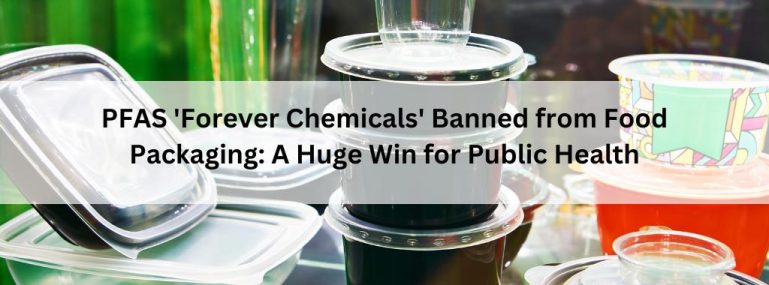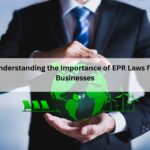For over 60 years, per- and polyfluoroalkyl substances (PFAS) have been manufactured for their extremely useful properties. These synthetic chemicals can repel water, oil, stains and heat, making them ideal for products like non-stick cookware, stain-resistant fabrics, firefighting foams and grease-proof food packaging and service ware.
Food packaging is one of the biggest uses of PFAS. These “forever chemicals” have been used in sandwich wrappers, pizza boxes, microwave popcorn bags, takeout containers, and bakery bags to prevent soaking through grease and moisture.
The problem with PFAS is that they do not break down easily in the environment or the human body. In fact, PFAS persists for thousands of years! As a result, these chemicals have become ubiquitous globally, contaminating soil, air, lakes, rivers, fish and wildlife.
Humans can ingest PFAS through contaminated food packaging, but also through other contaminated food and water sources. Chemicals accumulate in the body over time. Numerous studies on exposed human populations have linked higher PFAS levels to increased risks of health issues such as:
- Weakened childhood immunity and increased infection risk.
- Increased cholesterol levels
- Changes in liver enzymes
- Increased risk of obesity and weight gain
- Reduced fertility
- Increased risk of certain cancers
After years of pressure from environmental groups, poison control centres, and the Environmental Protection Agency, the U.S. Food and Drug Administration has now banned American food manufacturers from using PFAS in any new food packaging products sold in the country.
This ruling marks the completion of a 3-year voluntary phase-out process that the FDA began in 2020 when it first worked with manufacturers to remove certain PFAS used as grease-proofing agents.
Benefits/Effects/Impacts:
- Experts say this FDA ban on PFAS in food packaging will eliminate a major source of dietary contamination.
- PFAS exposure for millions of Americans. Even though it may take up to 18 months for existing.
- PFAS-treated packaging stocks to work through distribution channels, the benefit is that consumers will no longer be ingesting these toxic chemicals directly from food contact materials.
“This FDA-led effort represents a positive step forward as we continue to reevaluate chemicals authorized for use with, and in, food,” said Jim Jones, FDA deputy commissioner for human foods. “It underscores an important milestone in the protection of U.S. consumers from potentially harmful food-contact chemicals.”
“This is a huge win for the public,” added Graham Peaslee, a Notre Dame physicist who studies PFAS contamination and exposure pathways. “Nobody reads the wrapper of their hamburger to see if it has PFAS or not. It’s going to be a huge win that we don’t have to worry about where it ends up.”
Despite the significant progress made in phasing out PFAS from food packaging, experts emphasize that these chemicals persist ubiquitously in the environment due to decades of widespread use and disposal. Contamination of drinking water, meat, dairy, and crops remains a pressing issue, requiring remediation, filtration, and concerted efforts.
Nevertheless, the recent FDA ban represents a pivotal and eagerly awaited milestone in curbing one of the primary sources of PFAS exposure for Americans. As manufacturing and usage decline, experts anticipate a gradual reduction in environmental and human exposure levels.
The FDA reaffirms its commitment to ongoing evaluation of PFAS chemicals and pledges to update regulations based on the latest scientific findings, ensuring accurate risk determinations.
For companies navigating the complexities of PFAS regulation, ComplianceXL offers specialized support from experienced expatriates with in-depth knowledge of PFAS. Don’t hesitate to reach out to our specialists for guidance and assistance at any time.
FAQs:
Q: When will PFAS be completely removed from food packaging?
A: Most manufacturers have already ceased using PFAS in food packaging. However, it may take up to 18 months for existing stocks to sell through before they are eliminated from grocery shelves and restaurants.
Q: Are PFAS only found in food packaging?
A: No, PFAS compounds have been used in countless products and industries over the past 60+ years, including non-stick cookware, clothes, carpets, firefighting foams and more. Their widespread use has led to ubiquitous environmental contamination.
Q: Are there health risks from previous PFAS exposure?
A: Ongoing research shows potential links between high levels of PFAS in the body and adverse health effects like reduced immunity, increased cholesterol, changes in liver function, obesity, reduced fertility, and some cancers. Consult your doctor with any concerns.
Q: What alternatives will replace PFAS?
A: Manufacturers are expected to transition to other grease-resistant coatings and liners that do not contain PFAS compounds. Common alternatives include plant-based waxes and conventional polyethylene plastic liners.





